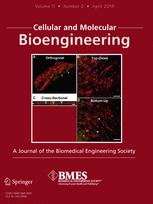
An article from Deanna Thompson's group has been promoted to journal cover of the journal Cellular and Molecular Bioengineering. The paper title is "Endothelial Cells Exposed to Fluid Shear Stress Support Diffusion Based Maturation of Adult Neural Progenitor Cells" and the citation information is
Dumont, C.M., Piselli, J., Temple, S. et al. Cel. Mol. Bioeng. (2018) 11: 117.
https://doi.org/10.1007/s12195-017-0516-5
The paper abstract is shown below: Introduction The neural stem cell (NSC) niche is a highly complex cellular and biochemical milieu supporting proliferating NSCs and neural progenitor cells (NPCs) with close apposition to the vasculature, primarily comprised of endothelial cells (ECs). Current in vitro models of the niche incorporate EC-derived factors, but do not reflect the physiologically relevant hemodynamic state of the ECs or the spatial resolution observed between cells within the niche. Methods In this work, we developed a novel in vitro model of the niche that (1) incorporates ECs cultured with fluid shear stress and (2) fosters paracrine cytokine gradients between ECs and NSCs in a spatiotemporal configuration mimicking the cytoarchitecture of the subventricular niche. A modified cone and plate viscometer was used to generate a shear stress of 10 dynes cm−2 for ECs cultured on a membrane, while statically cultured NPCs are 10 or 1000 μm below the ECs. Results NPCs cultured within 10 μm of dynamic ECs exhibit increased PSA-NCAM+ and OLIG2+ cells compared to progenitors in all other culture regimes and the hemodynamic EC phenotype results in distinct progeny phenotypes. This co-culture regime yields greater release of pro-neurogenic factors, suggesting a potential mechanism for the observed progenitor maturation. Conclusions Based on these results, models incorporating ECs exposed to shear stress allow for paracrine signaling gradients and regulate NPC lineage progression with appropriate niche spatial resolution occurring at 10 μm. This model could be used to evaluate cellular or pharmacological interactions within the healthy, diseased, or aged brain.


